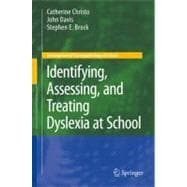
What is included with this book?
| Introduction and Overview | p. 1 |
| Why School Professionals Should Read This Book | p. 1 |
| School Success and Adult Outcomes | p. 2 |
| Association with Juvenile Delinquency | p. 2 |
| The Most Common Learning Disability Referral | p. 2 |
| Importance of Early Identification and Intervention | p. 2 |
| Changes in How School Professionals Respond to Dyslexia | p. 3 |
| Defining Dyslexia | p. 4 |
| History | p. 4 |
| Current conceptualizations | p. 5 |
| Common Questions About Dyslexia | p. 7 |
| Is Dyslexia Just the Low End of the Reading Skill Continuum? | p. 7 |
| Are There Different Types of Dyslexia? | p. 9 |
| Dyslexia and Special Education Eligibility | p. 10 |
| Purpose and Plan of the Book | p. 12 |
| Causes | p. 15 |
| Changes in Perspective of the Etiology of Dyslexia | p. 15 |
| Current Theoretical Views on the Etiology of Dyslexia | p. 16 |
| Visual Processing Approaches | p. 16 |
| Temporal Processing | p. 17 |
| Phonological Core Deficit | p. 18 |
| Dual Subtype Approaches | p. 18 |
| Multiple Subtype Approaches | p. 20 |
| Genetic, Neurobiological, and Environmental Contributions to the Understanding of Dyslexia | p. 21 |
| Genetics | p. 21 |
| Neurobiological Structures | p. 22 |
| Environment | p. 23 |
| Concluding Comments | p. 23 |
| Prevalence and Associated Conditions | p. 25 |
| Nonresponders | p. 26 |
| Prevalence in Special Education | p. 27 |
| Problems in Estimating Prevalence | p. 29 |
| Prevalence and Gender | p. 29 |
| Ethnicity | p. 30 |
| Cross Linguistically | p. 31 |
| Co-occurring Conditions | p. 32 |
| Attention-Deficit/Hyperactivity Disorder | p. 32 |
| Dyscalculia | p. 33 |
| Specific Language Impairment | p. 34 |
| Concluding Comments | p. 35 |
| Case Finding and Screening | p. 37 |
| Issues in Case Finding and Screening | p. 37 |
| Identifying Children Prior to School Entry | p. 40 |
| Family History | p. 40 |
| Language Development | p. 42 |
| Otitis Media | p. 45 |
| Preschool Screening Batteries | p. 45 |
| Kindergarten Screening | p. 48 |
| Visual Processing | p. 49 |
| Phonological Awareness | p. 49 |
| Vocabulary | p. 50 |
| Naming Speed Tasks | p. 50 |
| Early Literacy Skills | p. 51 |
| Screening as a Dynamic Activity | p. 51 |
| Screening Measures | p. 52 |
| Summary and Concluding Comments | p. 56 |
| Diagnostic Assessment | p. 59 |
| Reading Disorder | p. 60 |
| Diagnostic Criteria | p. 60 |
| Symptom Onset | p. 60 |
| Developmental Course | p. 61 |
| Associated Features | p. 61 |
| Gender-Related Issues | p. 62 |
| Differential Diagnosis | p. 62 |
| Disorder of Written Expression | p. 62 |
| Symptom Onset | p. 63 |
| Developmental Course | p. 63 |
| Associated Features | p. 64 |
| Gender-Related Features | p. 64 |
| Differential Diagnosis | p. 64 |
| Learning Disorder Not Otherwise Specified | p. 65 |
| Developmental, Health, and Family History | p. 65 |
| Perinatal Risk Factors | p. 65 |
| Developmental Milestones | p. 72 |
| Medical and Diagnostic History | p. 72 |
| Family History | p. 72 |
| Indirect Assessment | p. 73 |
| Concluding Comments | p. 74 |
| Psychoeducational Assessment | p. 75 |
| Special Education Eligibility: Overview of Federal Regulations | p. 75 |
| Response-to-Intervention Models | p. 76 |
| Low Achievement | p. 78 |
| Lack of Progress or Pattern of Strengths and Weaknesses | p. 78 |
| Exclusionary Factors | p. 81 |
| Appropriate Instruction | p. 81 |
| Comprehensive Evaluation | p. 82 |
| Operational Definition of Learning Disability | p. 84 |
| Diagnosis of Dyslexia | p. 87 |
| English Learners | p. 89 |
| Reading Skills Analysis | p. 93 |
| Word Reading | p. 94 |
| Assessment of Cognitive Processes | p. 97 |
| Age at Identification | p. 97 |
| Concluding Comments | p. 98 |
| Treatment | p. 99 |
| National Reading Panel's Report and Recommendations | p. 100 |
| International Dyslexia Association Recommendations | p. 102 |
| Programs, Curricula, and Interventions: Prevention and Intervention | p. 103 |
| Prevention and Intervention | p. 103 |
| Programs | p. 103 |
| Curriculum | p. 103 |
| Supplemental Intervention Reading Programs | p. 110 |
| Controversial Intervention Strategies | p. 113 |
| Auditory Processing | p. 113 |
| Visual Processing | p. 114 |
| Other Programs | p. 116 |
| Concluding Comments | p. 116 |
| Appendix | p. 119 |
| References | p. 125 |
| Index | p. 147 |
| Table of Contents provided by Ingram. All Rights Reserved. |
The New copy of this book will include any supplemental materials advertised. Please check the title of the book to determine if it should include any access cards, study guides, lab manuals, CDs, etc.
The Used, Rental and eBook copies of this book are not guaranteed to include any supplemental materials. Typically, only the book itself is included. This is true even if the title states it includes any access cards, study guides, lab manuals, CDs, etc.